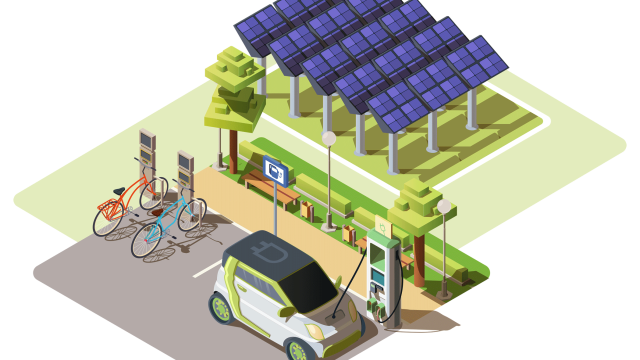| The 2024 Community Emission Reduction Grants Program will re-open on Monday, September 16. The deadline to submit applications is Friday, December 13. |
As we transition to a clean energy future, environmental justice is among our top priorities. To that end, LADWP is investing $20 million in grants for local projects that help reduce emissions in the L.A. communities hardest hit by pollution sources, such as refineries and truck traffic. Over the course of six years, from 2020 – 2026, LADWP is providing grants ranging from $100,000 to $500,000 to help fund innovative projects that reduce emissions in the Harbor and Northeast San Fernando Valley communities, located in Council Districts 2, 6, 7 and 15. Our local Harbor and Valley communities are disproportionately burdened by multiple pollution sources, such as refineries and truck traffic, and are ranked high in the CalEnviroScreen mapping program.
Grants are awarded on a competitive basis to the organizations that can present a dynamic proposal for projects in the categories of interest (listed below) benefiting Council District 2, 6, 7, or 15. Start-up costs can be up to 15 percent of the project.
Program Background
This program is LADWP’s response to Motion 18A which calls for a local version of Transformative Climate Community and is modeled after the California Strategic Growth Council’s Transformative Climate Community program. Funding is provided from the proceeds from the sale of California Air Resources Board’s Low Carbon Fuel Standard (LCFS) credits and the California Carbon Allowances.
Eligibility Guidelines
Applicants must be a 501(c)3 non-profit organization (in good standing), with a minimum of three years of service in the City of Los Angeles; or a public or regulatory agency.
- Propose a project to benefit Council District 2, 6, 7, or 15.
- Provide services to the community in the areas of: education, energy, water or economic issues.
- Have the capacity to provide comprehensive quantitative reporting, and maintain records suitable for a City financial audit. Metrics must include: number of constituents reached and referred, labor costs, expenditures, etc.
- Propose a project that provides greenhouse gas (GHG) emission reductions, and fulfills either the funding requirements of CARB’s Cap-and-Trade program or LCFS program.
- Start-up costs can be up to 15% of the project.
- 1% of the total costs for the project can be used for educational programs.
- If a previously selected grantee would like to apply for the program again, they must partner and jointly apply with an eligible non-profit organization who has not been selected previously. The other non-profit organization must be the lead of the grant program, and the previously selected grantee must be the secondary applicant.
- A detailed criteria for the program can be found here
How to Apply
The 2024 Community Emission Reduction Grants Program will re-open on Monday, September 16. The deadline to submit applications is Friday, December 13.
An example of a successful grantee work plan LA Compost Work Plan linked here for reference.
Interested grant applicants can attend workshops hosted by the California State University Northridge (CSUN) about details on the grant program and the application process. In addition to providing general information about the grant program, CSUN offers individual technical assistance for potential grantees to complete greenhouse gas emission reduction calculations and organize work plans. CSUN can also assist with responding to the grant application questions.
Detailed Grant Prep Sessions will be held on August 28th from 12:00 p.m. to 1:30 p.m. and September 5th from 4:00 p.m. to 5:30 p.m. to assist applicants in developing strong proposals.
These sessions will include:
- Eligibility criteria
- How to craft a compelling project narrative
- Budget planning
- A discussion of possible strategies for reducing emissions and meeting the goals of the project
Please register using the following links:
View the video below to learn more about the program.
Project Categories of Interest
Projects allowed under the Cap-and-Trade regulation:
- Renewable Energy or Integration of Renewable Energy
- Energy Efficiency and Fuel-Switching
- Switching from natural gas, propane, or diesel to electric equipment
- Energy-efficient equipment rebates or building retrofits
- Infrastructure projects including electric vehicle charging infrastructure
- Other projects supporting active transportation, zero-emission vehicles, or public transportation
Projects allowed under the LCFS regulation include projects that directly benefit current or future electric vehicle customers.
For more information about projects allowed by CARB’s Cap-and-Trade program, please see “(d)(3) Limitations on the Use of Auction Proceeds and Allowance Value” on pages 201-204 at the link to the regulation here. For more information about projects allowed by CARB’s LCFS program, please see “Specific Quarterly Reporting Parameters for Electricity used as a Transportation Fuel” on page 196 at the link to the regulation here.
2021 Past Projects and Awardees
- Climate Resolve – Cool Roofs and Solar Arrays Project. Climate Resolve is installing cool roofs and solar panels for eligible residents in Council District (CD) 15.
- Discovery Cube – Solar and EV Charging Project. Discovery Cube is installing solar shade structures and parking lot solar panels, as well as, doing electric vehicle (EV) improvements.
- Los Angeles County Bicycle Coalition (LACBC) – E-Bikes for Businesses Project. LACBC is purchasing e-bikes for a community ride-share e-bike program.
- Los Angeles Community College District (LACCD) – Electrification Project. LACCD is electrifying boiler equipment and landscape tools, and investing in outreach and education for energy efficiency measures.
- Los Angeles County Internal Services Department (ISD) – EV Charging Station Project. ISD is installing EV chargers in their parking lots.
- ONEgeneration – Education, Outreach and Electrification Project. ONEgeneration is helping community members sign up for EVs and energy-efficient infrastructure.
- Pacoima Beautiful – Electro Bici Program. Pacoima Beautiful is implementing an e-bike program for Pacoima residents.
- Toberman Neighborhood Center – Solar, Batteries & EVs Project. Toberman is installing a solar system carport, battery energy storage, and EV charging stations.
- U.S. Green Building Council Los Angeles (USGBC-LA) – Green Affordable Housing Project. USGBC is doing community outreach for EVs and installing EV chargers for residents.
2023 Past Projects and Awardees
- Campbell Hall Episcopal – Solar Panel Project. Campbell Hall is installing solar panels at their facility.
- Food Forward – Truck Replacement Project. Food Forward is replacing one diesel-powered 26-foot produce recovery box truck with an electric truck.
- Friends of Cabrillo Marine Aquarium – Solar Panel and EV Charger Project. Cabrillo Aquarium is installing a photovoltaic system via carports and canopies, and installing Level 2 EV charging stations.
- Girls Athletic Leadership School Los Angeles (GALS LA) – Electric Bus Project. GALS LA is purchasing a new electric school bus.
- GRID Alternatives Greater Los Angeles – Cool Roof Project. GRID is installing cool roof systems in the Pacoima area.
- Harbor Community Benefit Foundation (HCBF) – EV Charging Station and Electrification Project. HCBF is doing on-site installation of EV charging stations and induction cooktops for community members.
- LA Compost – Electrification, Solar, and EV Project. LA Compost is transitioning to electric and solar infrastructure, including an EV e-sprinter, electric-powered tractors, solar photovoltaic systems, solar-powered EV charging stations, and solar-powered forced compost aeration systems.
- San Fernando Valley Community Mental Health Center, Inc. (SFVCMHC) – EV Project. SFVCMHC is purchasing new passenger EVs and installing charging stations for employees and clients.
- The Niles Foundation – EVClean15 Project. The Niles Foundation is providing CD 15 Los Angeles residents with an EV community-accessible transport system by purchasing EVs and implementing a ride-share program.
- Watts Labor Community Action Committee (WLCAC) – EV Project. WLCAC is purchasing EVs for community members and employees.
Build Partnerships with Other Non-Profits for a Joint Application
Are you interested in partnering with another non-profit in the Los Angeles region to help support your grant, or expand the scope of your work? If so, please fill out the linked form to be added to a database of non-profits interested in a partnership. Please note that one grant application cannot request funding of more than $500,000, no matter the number of partners. Previously selected grantees must partner with another non-profit if they wish to apply for the program again.
To view the database of non-profits who are interested in a partnership, please click here.
Outreach Toolkit
Social Posts - Twitter I Facebook I Instagram I Linkedin
Project Deliverables
If selected for grant funding, non-profits will be required to:
- Work with LADWP to finalize work plan and execute a formal agreement which is subject to approval by the LADWP Board of Water and Power Commissioners.
- Submit a quarterly metric tracking with updates on project progress. The metric tracking sheet may include the following details:
- Funding used
- Emissions reduced
- Energy savings
- Jobs supported
- Submit requests for funding. Other than start-up funding, which can be provided before the project starts, grant funding will be awarded upon completion of work. The project’s scope of work will be split into three milestones, each with a funding amount reflecting the cost of completing the work. After the work is completed, grantees must fill out a Grant Installment Request (GIR) and submit supporting documentation such as invoices, receipts, and time sheets to substantiate their request for reimbursement. Once the GIR is approved, the grantee will receive their funding for completing that milestone within one month. This process will continue until the project is complete.
- Accommodate any inquiry or request from LADWP to audit the progress of the grant program.



